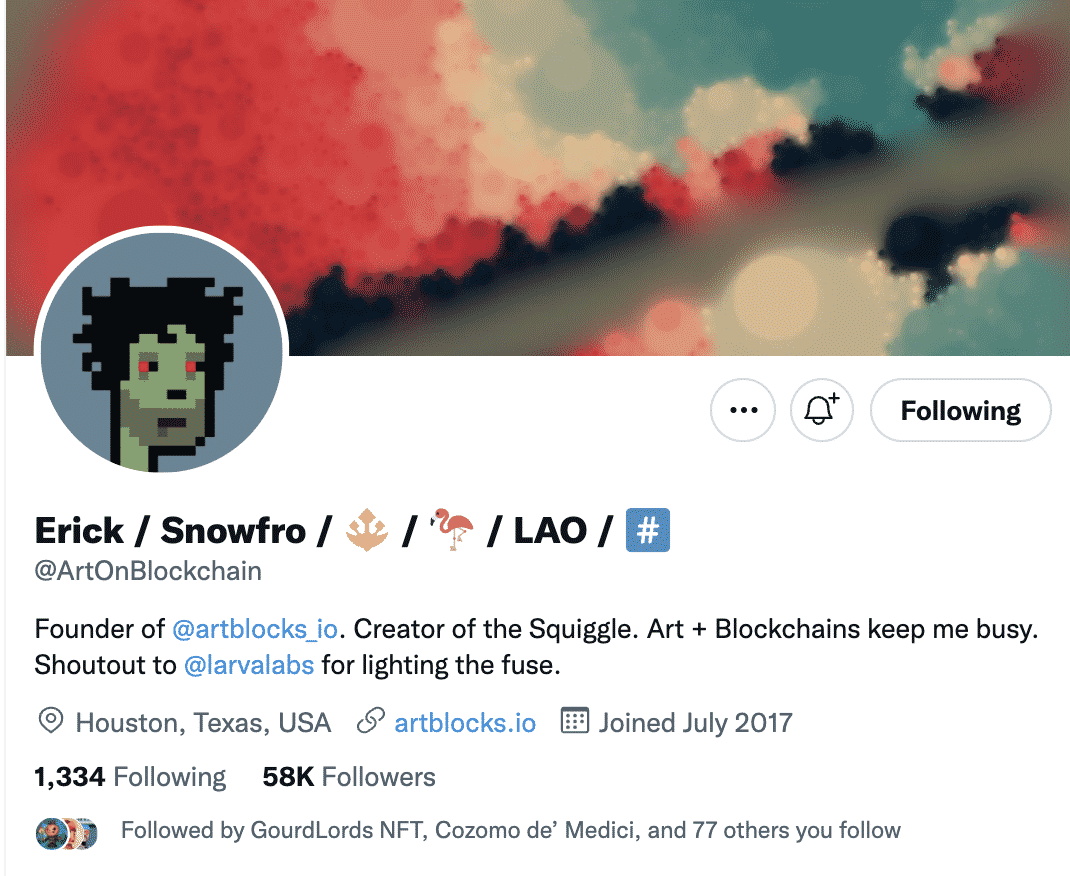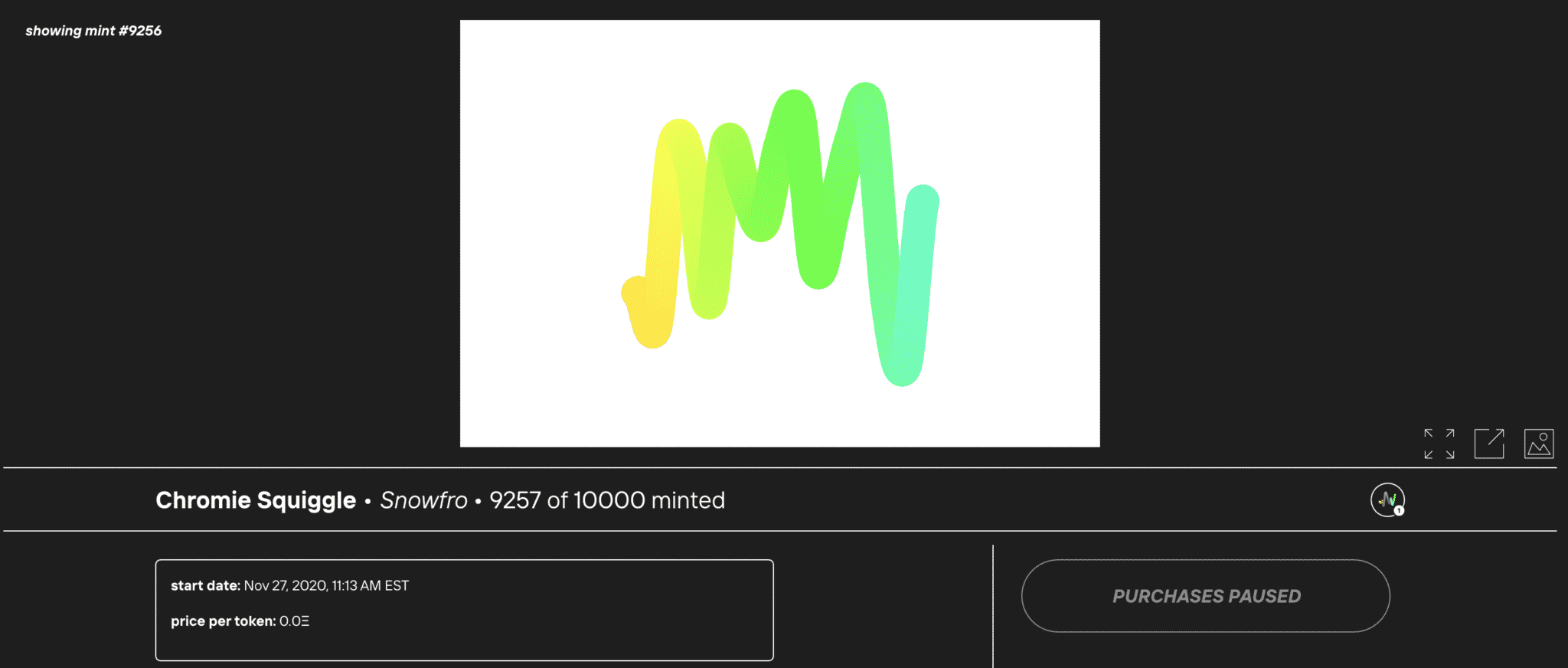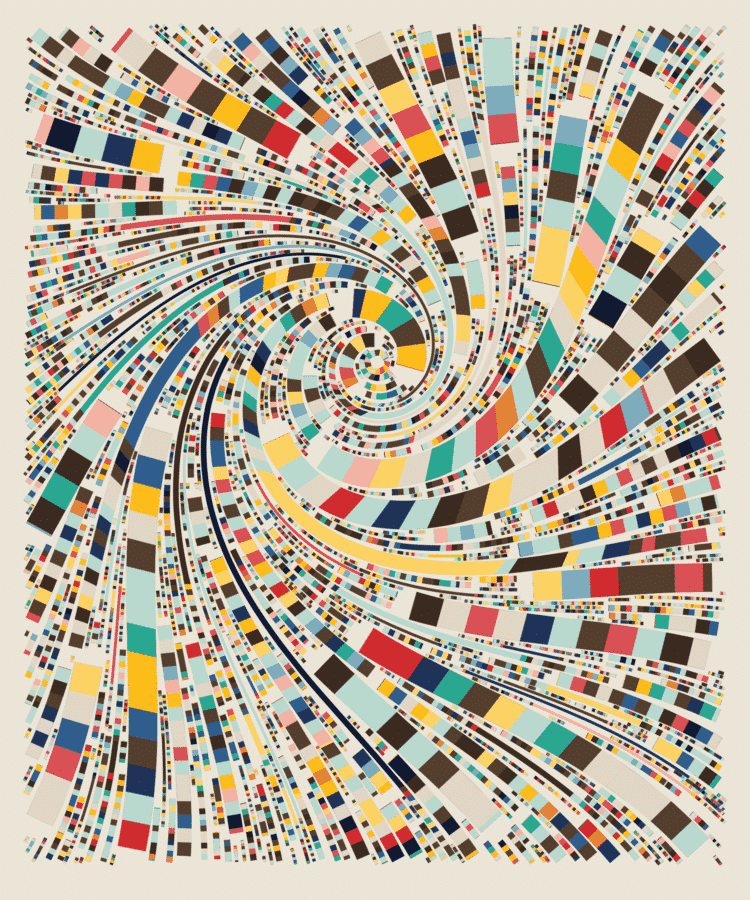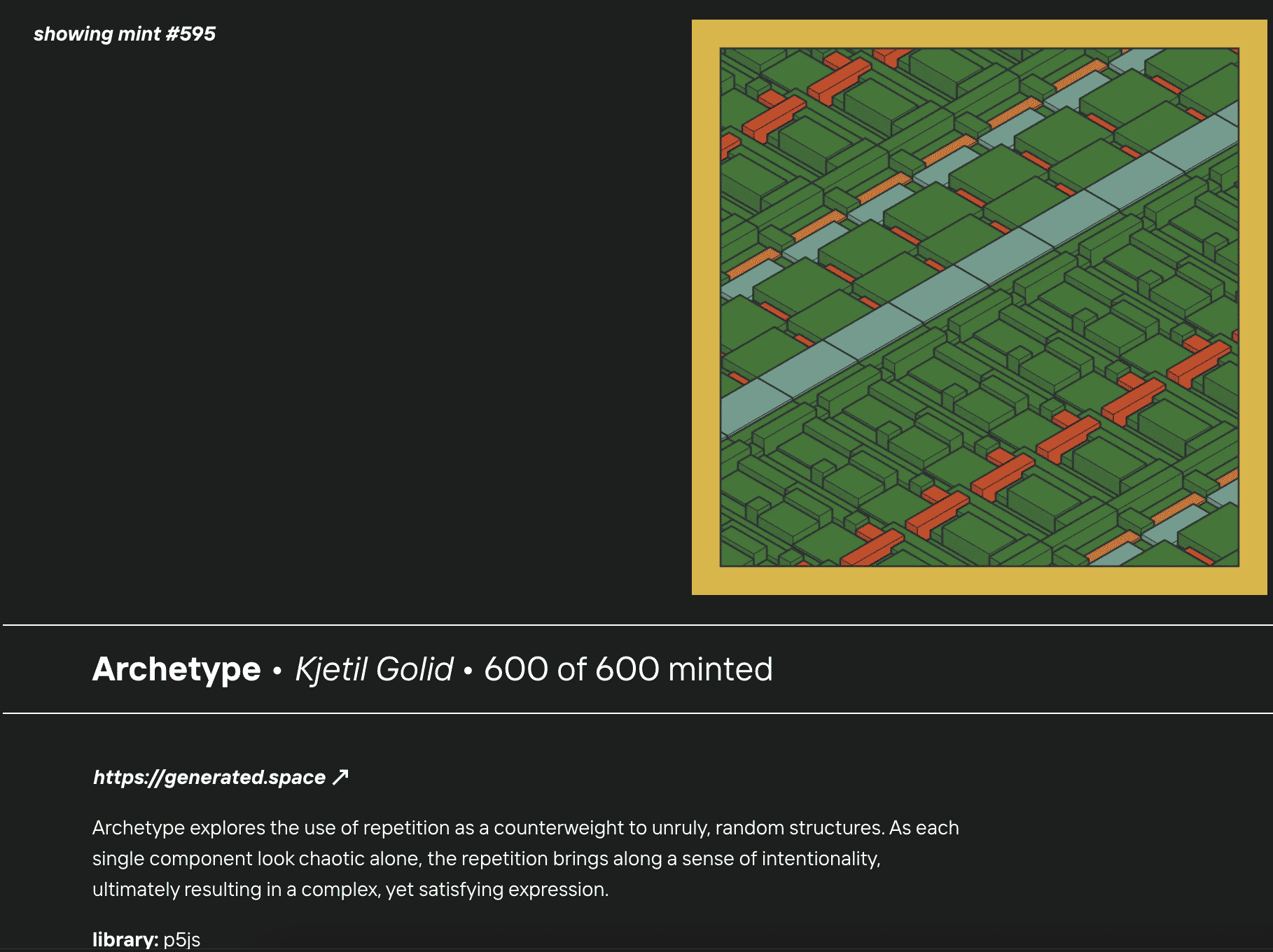Art Blocks is an Ethereum-based NFT creation platform where artists can create and sell on-demand generative art. Each output is one of a kind, and buyers typically don’t know how the artwork will exactly look before buying it.
This programmatic, or generative, type of art uses algorithmic processes that make the art creation autonomous. Random factors are introduced into the code to make each art piece unique.
Artists upload their algorithms to the Art Blocks platform and set the maximum number of editions to be minted. In some cases, collectors can pick a style from the options to generate the art. The artwork is minted in real-time on the blockchain as soon as it is purchased, and the output sent is a randomly generated art piece as an ERC-721 NFT, sent directly to the collector’s wallet.
Well-known NFT profile picture projects, like Bored Ape Yacht Club or Crypto Punks, also use the generative art process to randomize the creation of the 10,000 NFTs in their collection.
Some Art Blocks projects include interactive artworks, as in the case of Asterisms, while others can be static, as in the case of Archetype.
The Archetype NFT project
A Short History of Art Blocks
Erick Calderon, or Snowfro, launched Art Blocks in November 2020, citing the inspiration for the project coming from his experience claiming Cryptopunks in 2017. Calderon leaned on his tech-savvy and smart contract understanding to manipulate the minting process to acquire the CryptoPunks with the rarest attributes (the Zombies).

Snowfro on Twitter
The experience pushed Calderon to explore the creation of an NFT release where the end-user had no foresight into the NFT they would receive. He encrypted the NFTs properties within the code. Seeking to combine provenance with generative output, Snowfro launched the first collection on Art Blocks called the Chromie Squiggle.

Chromie Squiggle
This collection married uniqueness with simplicity. Each of the 10,000 pieces in the Squiggle collection was exactly that– a colorful squiggle with varying textures and opacities.
In 2021, Art Blocks blew past $100 million in sales volume, spread around a global base of over 9,000 collectors and traders. Its popularity seemed to hit a crescendo in March 2021, and the attention was magnified by Tyler Hobb’s release of the Fidenza collection on Art Blocks. This was around the same time generative art profile picture projects like Bored Ape Yacht Club began catching steam as well, overlapping many of the same collectors of Art Blocks.

Fidenze by Tyler Hobbs
Today, every piece from the Chromie Squiggle collection now is appreciated for its historic value and role in the early NFT ecosystem. At the time of writing, the floor price on the OpenSea marketplace is 6 ETH, and the all-time highest Squiggle sale was Squiggle #3784 for a whopping 750 ETH, or $2.44 million.
Art Blocks 101: How Art Blocks Works
To best understand Art Blocks, it’s helpful to know the basics of how NFTs work.
Non-Fungible Tokens, or NFTs, are tokens that are completely unique, and valued as such. So, Art Blocks takes control over the characteristics that make a project unique and gives it to an algorithm to generate. Since Art Blocks is built on the Ethereum (ETH) network, all the Art Blocks pieces are standard ERC-721 compliant non-fungible tokens.
As such, an artist creates a piece of code that is uploaded to Art Blocks, and random combinations of the variables are generated. Most Art Bocks projects are created using a JavaScript framework that supports creative coding called p5.js.
Upon submitting their code to Art Blocks, the following sequence happens behind the scenes:
- A seed, or randomized hexadecimal string is made.
- Each element in the seed specifies an attribute of the artwork within the parameters that are consistent with the artwork’s aesthetic. For example, the Chrome Squiggle algorithm wouldn’t just start randomly dropping emojis in the works, unless that’s what the creator specified in the programming.
- Finally, the end-product is created. The variations all come down to what the algorithm spits out– one could specify a yellow hue, whereas one could be green, and so on.
The final NFT could be anything from a 3D model, interactive experience, or simply just a static image.
There are three types of projects on the Art Blocks platform.
Curated: These projects include the collections which are approved by the Art Blocks’ curation board. They represent the platform’s official vision the best. The projects in this category are released in quarterly sets.
Playground: These projects don’t undergo a deep review process, and are more experimental in nature. Only those artists who have already released curated projects on the platform before can be chosen for the Playground projects. It’s a way Art Blocks supports the artists it already works with to play around with novel ideas. An artist can only have one active playground project at a given time. To submit a new project of this type, the artist must release another curated project first.
Factory: This general collection is open to artists who are not considered for the curated collections. The artists must sell all their Factory artwork before releasing another Factory project on the platform. Artists must also wait for two months in-between project launches.
Art Blocks projects are typically sold as Dutch auctions; the price starts at an initial minting price and decreases by a fixed amount periodically until it reaches the lowest price that the project will sell out.
The most popular secondary market for ETH-based NFTs is OpenSea, and the various Art Blocks are particularly popular.
Per Cryptoslam data, the total sales volume is $1,161,060,106.15 as of the 16th of January 2022.

Art Blocks sales volume history
Most Famous Art Blocks Projects
The most economically successful Art Blocks project is the Fidenza series created by artist Tyler Hobbs. The collection recorded 42,164,650 ETH all-time volume on the OpenSea platform, and the artworks regularly sell for over $200,000. At the time of writing, the Fidenze floor price is 76 ETH.
The collection, named after an Italian town, created 999 pieces of generative art inspired by the abstract expressionist painter Francis Klein’s artworks. It launched at an initial mint price of 0.17ETH.
Ringers by Dmitri Cherniak is another notable Art Blocks project. Cherniak, a prominent figure in the generative art circles, explores the concept of wrapping a string around a set of pegs where the algorithm could produce an almost infinite number of combinations. The collection’s floor price is 41 ETH on the OpenSea platform at the time of writing.
The Archetype project by Kjetil Golid studied how the inclusion of repetition as a counterweight to random structures could cause a sense of intentionality.
The Archetype #467 was included in the well-known auction house Christie’s “Post-War to Present: The NFTs” auction.
Art Blocks Sotheby’s Auctions
In June 2021, Sotheby hosted an auction called “Natively Digital: a Curated NFT Sale / Lot4”. The Lot included 19 artworks handpicked by Erick Calderon and Jeff Davis from their Art Blocks collections and was sold for $81,900.
In December 2021, ten never-before-minted editions from the original Chromie Squiggle collection were included in Sotheby’s Metaverse auction. The collection was found by a buyer for $478,800.
Sotheby’s and Snowfro @ArtOnBlockchain proudly present an iconic sale for an icon of generative art. Chromie Squiggle: MINT IT! features one lot of 10 unminted, never before seen Chromie Squiggles. Bidding is open now through Dec 13 https://t.co/hZvYIkO3xx pic.twitter.com/9iHcb6rJ3Z
— Sotheby’s Metaverse (@Sothebysverse) December 6, 2021
Final Thoughts: Why Art Blocks Matters
The Art Blocks platform contributes much to the development, reputation, and appreciation of generative art because the artists have to accept every single output of the algorithm they create; they can’t just filter the outcomes and choose the best results to show to the public.
As the founder Snowfro said in an interview, art enthusiasts have the opportunity to acquire a little sliver of an artist’s soul through their generative art on the platform. He emphasizes that the platform will strive to explore the sense of individuality and accessibility to the art over the next few years.
Art Blocks collections are algorithmically sophisticated, aesthetically appealing, and have a fairly high bar for their curated content. Art Blocks experienced a meteoric rise in popularity, evolving from a niche art startup project into a blue-chip NFT studio of sorts, and it holds a unique role in blockchain art history.
The post What is Art Blocks? A Guide on the NFT Art Pioneer appeared first on CoinCentral.






















